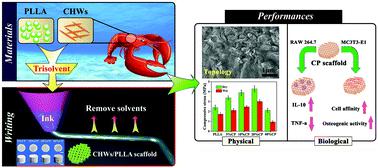Our official English website, www.x-mol.net, welcomes your feedback! (Note: you will need to create a separate account there.)
Fabrication and evaluation of a chitin whisker/poly(L-lactide) composite scaffold by the direct trisolvent-ink writing method for bone tissue engineering.
Nanoscale ( IF 6.7 ) Pub Date : 2020-08-05 , DOI: 10.1039/d0nr04204h Kun Liu 1 , Ling Zhu 1 , Shengyue Tang 1 , Wei Wen 2 , Lu Lu 2 , Mingxian Liu 2 , Changren Zhou 2 , Binghong Luo 2
Nanoscale ( IF 6.7 ) Pub Date : 2020-08-05 , DOI: 10.1039/d0nr04204h Kun Liu 1 , Ling Zhu 1 , Shengyue Tang 1 , Wei Wen 2 , Lu Lu 2 , Mingxian Liu 2 , Changren Zhou 2 , Binghong Luo 2
Affiliation

|
Although poly(L-lactide) (PLLA) based porous scaffolds have been widely fabricated through 3D printing, their poor mechanical properties and osteogenic activity still do not meet the needs of bone tissue repair. Herein, chitin whiskers (CHWs), having outstanding mechanical properties, excellent cell affinity, osteogenic activity, etc. were designed to introduce into the PLLA matrix. Moreover, a trisolvent system, including dichloromethane (DCM), 2-butoxyethanlol (2-Bu) and dibutyl phthalate (DBP), instead of a single solvent system of DCM was chosen to prepare CHW/PLLA (CP) composite inks. Then, the CP porous composite scaffolds were further fabricated via the direct ink writing method. The as-printed CP composite scaffolds have good 3D porous structures with a pore size of 400 ± 14 μm and a porosity of 80 ± 5%. Compared with the pure PLLA scaffold, the CP composite scaffolds showed significantly superior hydrophilicity and compression performance, and also were more conducive to cell adhesion, proliferation, and up-regulating alkaline phosphate activity and calcium deposition due to the presence of CHWs. Moreover, these promoting effects of CHWs are positively related to the content of the whiskers in the range of 0–20 wt%. However, as the content of CHWs further increased to 40 wt%, the compression performance, cell affinity and osteogenic activity of the corresponding 40%CP composite scaffold decreased, which may be attributed to the different microstructure of the scaffold from other composite scaffolds. Interestingly, compared with these scaffolds containing a lower mass content of CHWs, only the 40%CP composite scaffold exhibited significant anti-inflammatory properties. These robust CP composite scaffolds offer a new route for bone tissue engineering application.
中文翻译:

甲壳素晶须/聚(L-丙交酯)复合支架的制备和评估,采用直接三溶剂墨水书写方法进行骨组织工程。
尽管已经通过3D打印广泛地制造了基于聚(L-丙交酯)(PLLA)的多孔支架,但是其差的机械性能和成骨活性仍然不能满足骨组织修复的需要。在此,几丁质晶须(CHW)具有优异的机械性能,优异的细胞亲和力,成骨活性等。被设计为引入PLLA矩阵。此外,选择了包括二氯甲烷(DCM),2-丁氧基乙醇(2-Bu)和邻苯二甲酸二丁酯(DBP)的三溶剂体系,而不是DCM的单溶剂体系来制备CHW / PLLA(CP)复合油墨。然后,通过以下步骤进一步制造CP多孔复合支架直接墨水书写方法。印刷后的CP复合材料支架具有良好的3D多孔结构,其孔径为400±14μm,孔隙率为80±5%。与纯PLLA支架相比,CP复合支架表现出明显优越的亲水性和抗压性能,并且由于存在CHWs,也更有利于细胞粘附,增殖以及上调碱性磷酸酶活性和钙沉积。此外,CHW的这些促进作用与晶须含量在0-20 wt%范围内呈正相关。但是,随着CHWs含量进一步增加至40 wt%,相应40%CP复合支架的压缩性能,细胞亲和力和成骨活性降低,这可能归因于该支架与其他复合支架不同的微观结构。有趣的是,与这些CHWs含量较低的支架相比,只有40%CP复合支架表现出显着的抗炎特性。这些坚固的CP复合支架为骨组织工程应用提供了一条新途径。
更新日期:2020-09-18
中文翻译:

甲壳素晶须/聚(L-丙交酯)复合支架的制备和评估,采用直接三溶剂墨水书写方法进行骨组织工程。
尽管已经通过3D打印广泛地制造了基于聚(L-丙交酯)(PLLA)的多孔支架,但是其差的机械性能和成骨活性仍然不能满足骨组织修复的需要。在此,几丁质晶须(CHW)具有优异的机械性能,优异的细胞亲和力,成骨活性等。被设计为引入PLLA矩阵。此外,选择了包括二氯甲烷(DCM),2-丁氧基乙醇(2-Bu)和邻苯二甲酸二丁酯(DBP)的三溶剂体系,而不是DCM的单溶剂体系来制备CHW / PLLA(CP)复合油墨。然后,通过以下步骤进一步制造CP多孔复合支架直接墨水书写方法。印刷后的CP复合材料支架具有良好的3D多孔结构,其孔径为400±14μm,孔隙率为80±5%。与纯PLLA支架相比,CP复合支架表现出明显优越的亲水性和抗压性能,并且由于存在CHWs,也更有利于细胞粘附,增殖以及上调碱性磷酸酶活性和钙沉积。此外,CHW的这些促进作用与晶须含量在0-20 wt%范围内呈正相关。但是,随着CHWs含量进一步增加至40 wt%,相应40%CP复合支架的压缩性能,细胞亲和力和成骨活性降低,这可能归因于该支架与其他复合支架不同的微观结构。有趣的是,与这些CHWs含量较低的支架相比,只有40%CP复合支架表现出显着的抗炎特性。这些坚固的CP复合支架为骨组织工程应用提供了一条新途径。



























 京公网安备 11010802027423号
京公网安备 11010802027423号